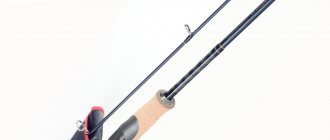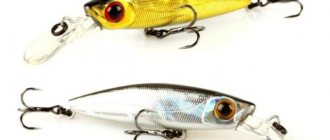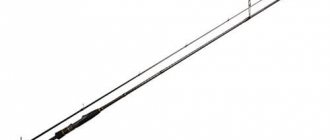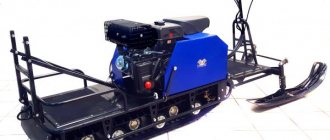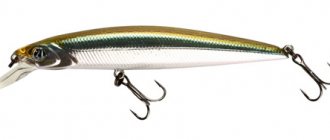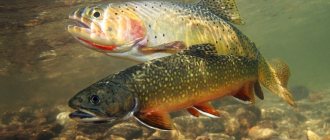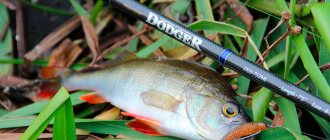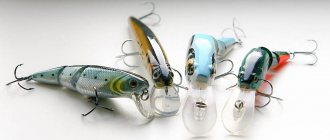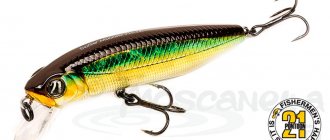What is twitching
Twitching is fishing with a spinning rod using wobblers with special jerks, the purpose of which is to make the plastic imitation of live bait indistinguishable from a real fish in order to mislead and catch pike, perch and other predators.
Standard postings of this type: moving the wobbler up and down or from side to side with jerks of the rod that are inconsistent in amplitude, frequency, and strength. As a result, the predator should get the impression that the bait has the main difference between living creatures and inanimate objects: the unpredictability of the direction and speed of movement.
The main tasks of an angler when twitching are to understand for himself what and why is required of him to achieve success, choose the right gear for this and correctly apply it when fishing. When choosing a spinning rod and its equipment, he must take into account the following factors:
- The tackle should provide maximum aggressiveness and the possibility of quick variations of wiring;
- Ensure that the wobbler is immersed to the greatest possible depth;
- Be adapted to the nature and weight of the bait;
- The current speed in a particular body of water must be taken into account.
Fishing technique
For the twitching technique, you can use basically any type of bait.
But classic twitching is fishing with minnow wobblers. Wobblers with different bends will be effective for the types of play that correspond to them. For example, an elongated wobbler allows you to make jumps to the side better expressed. By changing the shapes and colors of baits in the place chosen for fishing, you can determine what is best for catching fish right here and now.
Classic twitching wiring: we animate the wobbler only with brush movements. We use the reel only to reel out slack line between pulls. With sharp jerks we immediately give the wobbler the required speed. After the jerk, we loosen the line slightly so that the wobbler makes the maneuver. We make a pause, in which the bait hangs for a while, like an ordinary fish. The amplitude of jerks and the duration of pauses are determined experimentally.
The main thing in this fishing technique is to never get hung up on one thing, on the once successful solutions found. Twitching fishing involves constant creativity and search. Observe the behavior of the fish and try to get used to its image “according to Stanislavsky’s system.” Then the predator will believe you.
Fishing with suspended wobblers for beginners
To begin with, I recommend purchasing two shallow water “Husky Jerk” suspenders: 7cm and 12cm long. The first is optimal for perch and small pike, the second is good for catching “toothy” ones from 0.5 kg and above. These models are truly universal, that is, they work on any wiring: uniform, “stop and go,” twitching or jerking. To begin with, choose a color that is not bright or shiny, but as close to natural as possible. Remember that the suspender moves slowly, with stops, and the fish has time to look at it.
If where you fish there is a lot of small (50-100g) perch, then it is better to take a model with a length of 4-6cm.
Any fishing line is suitable, but preferably braided, with a real breaking load of 4 kg, so as not to be afraid of snagging on the grass. For example, I use “Power Pro 10 lb” braid.
Although this is not “scientific”, I always fish with a leash and I recommend that you use one too. After all, in every fourth or fifth case a small wobbler ends up completely in the pike’s mouth. If there is no leash, then even a braided line will not save you: you will lose both fish and bait. There is no need to remind you that a good wobbler is an expensive toy, but a leash is much cheaper.
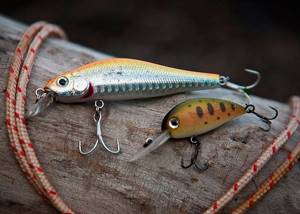
Of course, the leash partially upsets the balance of the bait, especially a small one, so we will choose the shortest and thinnest one. If necessary, you can remove the clasp and even the carabiner from the leash: many wobblers already have a ring where the loop of the leash is inserted, and the fishing line is tied to the second loop. For the smallest baits, homemade leashes made of thin leash material are used.
Although often a leash, on the contrary, helps to turn a floating model into a real suspender. After all, strictly speaking, the “super-fat” according to the label is a floating wobbler, but with a “standard” leash it “hangs” and becomes a real suspender.
It is better to start fishing with suspender in shallow places, near the grass, where pike and perch are found.
To begin with, use the reel in the mode “2-3 turns of the reel - pause 1 second”, while the rod is in its normal position and ready to hook. From time to time, make sharper jerks with the rod to make the bait “sound” louder - this attracts fish from afar.
Try not to allow the line to sag too much when you stop reeling; it is at this moment that a bite usually occurs. Sometimes the pike attacks “with a blow”, and sometimes the bite is not even felt, and only with the next reel in does the weight feel on the line - hook it immediately! If the wobbler has a bright back, then in shallow water the bite is often determined visually, and only a second later a weak “poke” is transmitted along the line.
When fishing with pauses, our success largely depends on the sharpness of the hooks, so it is advisable to have a diamond file with you. An extractor will also be very useful, because removing a wobbler from a toothy mouth is not an easy task. Although these are already rules common to all wobblers.
But you don’t have to fish with a suspender all the time. After all, you can catch fish both by “quality” and “quantity” of casts. Therefore, I usually start with a floating model to initially fish a larger area and gauge the bite activity. If the fish is hungry, then you don’t even have to take out the suspender - with a regular wobbler, fishing will go two to three times faster, and the catch will be greater. You can try the suspender on the way back to check interesting places again and try to catch the remaining passive predators. It is rational to fish with it all the time only when fish for some reason accumulate in certain areas, and here our catch can become a record one.
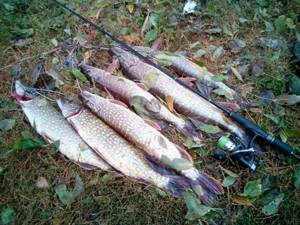
But predators are not always active. Often the pike goes after the bait, but does not dare to grab it, something worries it. It's time to try the suspender! And the lazier the predators, the more attention should be paid to “hanging” wobblers.
But do not forget that the suspender is a bait for local use. If the fish has played, we see it, or at least with sufficient probability we assume that it is nearby - then we install a suspender. We come to an interesting place: be it a turn, a hole, a grassy toe - we install a suspender.
But you shouldn’t get hung up on it. After all, if the fish doesn’t take it, this does not mean that our bait is bad. Some predators may be “punctured”, while others temporarily have no appetite. I remember a case when, on a 10-meter section of a river, 4 pike came out behind a wobbler, but even with suspenders I couldn’t catch a single one. However, after 2 hours on the way back, all 4 fish almost in a row were caught on a floating wobbler with the usual uniform reeling. Have you worked up an appetite?
What's good about the Husky Jerk is its versatility. This wobbler attracts fish not only at stops, but even during regular even movement, which is generally not typical for suspenders that were designed for intermittent movement. Therefore, most of these baits do not attract fish “on a constant course”, and this cannot be required. It's even nicer that there are a few exceptions.
After all, it is always useful to change tactics if the fish gets used to it. Once I was throwing a suspender around a hole at a bend in the river. I took two pikes on the right and one on the left, but two more “toothy” ones were hovering around the bait, but did not want to take them. No matter how hard I tried! I changed the pace of the jumps, increased the pauses - it was useless! Probably the wiring has become boring. Finally, I decided to move the wobbler evenly. Cast to the left, cast to the right - and both pikes are on the shore. But this is the exception rather than the rule.
In most cases, it is the suspender that still allows you to “get” even passive fish. And especially its “sliding” model. The game of such a bait is very specific: no active oscillations, only sluggish swaying to the sides. But it is precisely this kind of sluggish “prey” that even an apathetic pike can do. Therefore, let there be a passive option in our assortment.
A narrow mini-perch suspender, for example “Husky Jerk-6 cm,” will also not hurt. With such a wobbler in the summer, you can wander around the grassy shallows all day long, fishing for striped bass here and there, even in the heat, when the rest of the fish no longer take it. And when by the end of summer the perch gathers in schools, you will more than once see several fish attacking the mini-suspender at once.
Having mastered the “stop and go” technique, gradually switch to twitching and jerking. Start with the simplest options: 2 short twitches or 1 more energetic jerk (for twitching and jerking, respectively) - a 1 second pause while lowering the rod and “picking up” the line with the reel. In the future it will be easier to move on to more complex techniques.
After shallow-water models are mastered, it is the turn of deep suspenders. I recommend a wobbler with a dive of 1.0-1.5 m, for example DUEL 3D-100 or 150. The fact is that you often have to fish along the edge of algae, as well as on shallow river riffles. In both cases, the depth is usually about 2 m, and a suspender held “in half the grass” or over stones will certainly attract the attention of a predator.
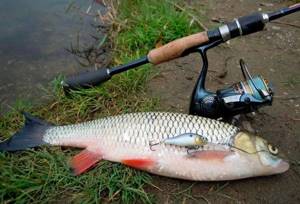
And finally, if you have suitable depths and desire, you can try fishing with a deep suspender “dive”. When you catch your first fish this way, you can safely consider yourself a spinning master.
In conclusion, a few words about how to expand the range of your suspenders. Some floating wobblers, especially small ones, have weak buoyancy. Then, with a small load, for example, installing a leash or thicker hooks, they become a kind of suspenders - and this means that effective wiring of such baits with stops and hovering is already possible. However, it will not always be possible to achieve complete transformation, because a real suspender also attracts fish with an acoustic effect, which is calculated specifically for “individual” intermittent wiring.
How to choose a spinning rod for twitching
Practice shows: in most cases, the optimal tackle for this fishing technique is a spinning rod with the following parameters:
- light rod with medium-fast action, 210-240 cm long;
- lightweight spinning reel size 1000-1500, in extreme cases 2000;
We pay special attention to the maximum lightness of the rod and its balance with the reel - otherwise the hand will quickly get tired from irregular sudden movements. braided fishing line can withstand sharp jerks of a wobbler . If we go pike fishing, we also need to have a leash.

The first thing you need to do when choosing a spinning rod is to carefully examine whether there are any splits or cracks on the rings. Most rings are made from ceramic. But there are designs in which it is absent altogether. It is also possible that the ceramics flew off during transportation. If you have the slightest doubt, you should refuse the purchase.
Next, you need to carefully examine the rod blank from the handle to the tip. A dent or deep scratch on it will cause the rod to break under heavy load in this place.
The spool holder clamping nut should tighten easily and quickly without loosening on the thread. Otherwise, it will scroll when tightened.
Quality of pass rings
The service life of the fishing line depends on the quality of the spinning rings. Accordingly, from this point of view, they should be as resistant to damage as possible, smooth, light and hard.
The number, location, and diameter of the rings greatly influence the possible casting distance. This is especially true when working with light baits on telescopic rods, because rings are placed on them where the design allows, and not in accordance with calculations. It happens that when fishing, the leash gets pushed into the upper passage ring. If this is not noticed in time, it may crack.
In composite two- and three-legged fishing rods from popular brands, the distance between the rings is calculated using computer diagnostics of the influence of loads of different intensity on the behavior of the blank during jerking. There is no reason not to trust these calculations. When fishing with branded spinning rods, you will get real pleasure. On the other hand, telescopic fishing rods are cheaper and more mobile. You have to choose your priorities yourself.
Test of twitching spinning rods
Light wobblers should be thrown with light test rods (light or ultralight)
The spinning test shows in grams the upper and lower weight limits of the lures that you will use when fishing. These limits characterize the power of the spinning rod, which is divided into classes:
- ultralight – test 0.5–7 g
- Light (light) – 5-15 g;
- Medium (average) – 10-30 g;
- Heavy (heavy) – 20-50 g;
- super heavy (jerk) - over 50 g of dough;
The test of the rod determines how conveniently and accurately it will be possible to cast a bait of a specific weight with it, as well as how accurately you can catch the movements of the bait in the water. At the same time, one must strictly observe the rule: under no circumstances should you exceed the upper limit of the test!
The power of the blank you require is determined by the expected weight of the bait and the type of fish you will catch with it. It is better that the weight of the wobbler is somewhere in the middle of the spinning test range. For example, a bait weighing 20 grams will be ideal for a 10-30 g blank.
For twitching, the standard spinning test is 5-30 g. When using ultra-light wobblers, you can also use ultralight spinning rods.
For example, the Favorite Varita 662 UL spinning rod will reveal to the amateur all the delights of ultra-light fishing, but is suitable only for this narrow purpose. Domestic fishermen most often choose medium-light fishing rods with a dough weight of 5 to 25 grams.
If you use baits with large blades, when choosing a fishing rod, you need to take into account not only the weight of the wobbler, but also its high resistance when retrieving. The optimal combination of wobbler and blank is achieved if, when twitching the bait, only the tip of the fishing rod is played.
Rod length
The length of the spinning rod is indicated in centimeters on the form. Its choice depends on the conditions, technique and fishing distance. For twitching, rods with a length of 210-240 cm are usually used.
It’s not easy to work with a large “stick”; your hand gets tired quickly. But if you have to fish from a bank densely overgrown with grass, or you have to cast a heavy wobbler long-distance, you may need a rod up to 3 meters long. However, this form is more suitable for the jig technique.
If you often have to cast between trees or from bushes , it is very inconvenient to do this with a long fishing rod. In such places, rods with a length of 180-210 cm are used.
The same length is ideal when fishing from a boat. Instead of long casting, you can simply swim to the fishing spot. In addition, using a long fishing rod while sitting is very inconvenient.
By fishing distance we mean the size of the reservoir. On a narrow river there is no point in a long spinning rod. And on the reservoir, a short fishing rod is only suitable for fishing from a boat.

On small reservoirs overgrown with shrubs and trees, it is not possible to use long rods
Rod build
Each technique, fishing conditions, and baits used have their own optimal spinning rod structure. It is determined by the nature of the bend of the fishing rod if some kind of weight is suspended from its tip.
The construction happens:
- slow;
- average;
- fast;
- transitional between the above;
People usually start learning to fish with a uniform retrieve. A medium rod action would be ideal for her.
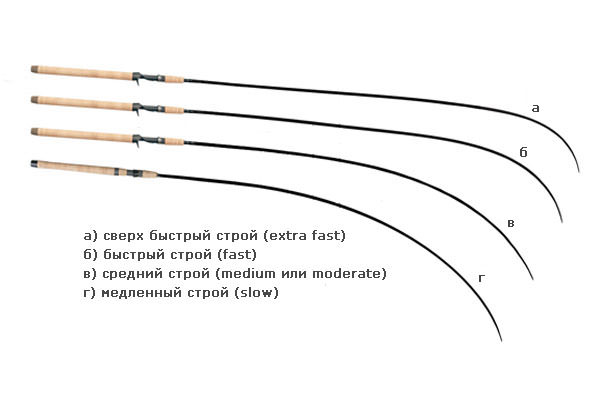
For twitching fishing, a medium-fast action would be ideal. It makes it possible to alternate soft and fast twitches.
For twitching from the beach, medium and slow action fishing rods will be used. There is room to swing, the main thing is that your arms don’t get tired.
And on a forest river, where branches hang overhead, only a sharp cast with a brush is possible. In this case, a short, inflexible, fast-action rod would be ideal.
The lighter the wobblers used, the slower the action of the rod should be.
Ultralight blanks, for example, can have a parabola from butt to tulip. And for twitching with heavy wobblers, a fast-action spinning rod is best. With it you can not be afraid of strong winds, make long casts, and you get an excellent hook. This is especially true when fishing for pike perch or pike.
Blank and handle material
Lightness is important for twitching, so the only material option from which spinning rods in this segment are made is carbon.
When you buy a spinning rod for twitching, ask for models specifically for this type of fishing. You will see that they are made of carbon fiber (carbon fiber). An angler with a spinning rod constantly comes into contact with the butt - the handle. It can be made of rubber, leather, cork, and be one-handed, one-and-a-half or two-handed.
We recommend cork handles for spinning rods. Your hands don’t freeze on them in cold weather and don’t slip. The criterion here is maximum ease and convenience. To reduce the weight and price of the butt, it is often covered with cork only at the point of contact with the hand.
The coil holder is located on the butt; it must securely fix it and be made of the appropriate material. The spinning reel holders are usually located at the bottom. For inertial ones, it is on top, and a trigger is added to the design - a special trigger that prevents the reel from spinning.
General requirements
Spinning rods for wobblers must have a number of qualities necessary for fishing with lures of this category. Moreover, depending on the models used, the characteristics of the rods can vary significantly. The main ones for fishing rods are:
- length,
- test,
- build.
Also, the performance indicators are influenced by the material from which the spinning rod is made, the fittings with which the “stick” is equipped, etc. It is also important how the tackle is equipped, starting with the reel and ending with the leash or clasp.
In any case, the chosen spinning rod should allow you to cast the wobblers used, cast them with different retrieves, fully control the behavior of the bait, record bites, hook fish and confidently fish them out.
Length
It is not customary to use long “rods” for fishing with wobblers. As a rule, the height of a spinning rod for these purposes ranges from 1.83 to 2.28 meters. This is the optimal range in which it is convenient to work with minnows, cranks, and topwaters.
Advice! When fishing at a long distance, it is advisable to take a taller “stick”. However, this will limit the angler's options regarding the variety of bait animation techniques.
A short fishing rod makes it easier to perform varied jerking movements. All other things being equal, it has less weight, so it is not so tiring during the fishing process. However, with a long rod it is easier to avoid obstacles and cast the bait over a long distance.
Test
The spinning test for wobblers is a parameter that determines in what weight range the rod can operate. According to this indicator, all fishing rods are divided into the following categories:
- Ultralight. Designed for fishing with wobblers weighing from 0.5 to 5 grams;
- Lungs (light). Focused on baits from 5 to 12 grams;
- Medium. Used for fishing with wobblers from 12 to 20 grams;
- Heavy. For wobblers from 20 grams and above.
The most popular are light and medium rods, since they allow you to fish with the most versatile wobblers that can catch any predatory and semi-predatory underwater inhabitant. Heavy “sticks” are used for targeted hunting for heavy specimens and trophies, while ultra-light ones make it possible to catch many peaceful representatives of the ichthyofauna.
Famous manufacturers try to indicate the real test, even slightly underestimating it in order to prevent the form from breaking during a power cast. Labels on budget spinning rods should not always be trusted. You need to test the capabilities of the model yourself, carefully increasing the weight of the bait.
Spinning reel for twitching
The coil is selected correctly
There are two types of spinning reels:
- inertialess;
- inertial multiplier;
Inertia-free ones are the easiest to use. With their help you can cast the lightest baits.
Inertia-free reels for twitching differ from inertial reels mainly in that the line flies off the spool under the weight of the wobbler being cast, and not from the rapidly spinning drum, which received an impulse only at the very beginning of casting.
At the same time, the spinning rod usually comes with one or two protective spools and a balsa wood insert. The main advantage is that when throwing them you do not need to slow down with your hand. When fishing with light baits, the spool must be filled almost to the very brim.
Of the inertial ones, it is advisable to use only baitcasting reels for twitching , starting from the middle class, since it is difficult to cast light wobblers with a fishing rod with such a reel normally. Their advantage is their long service life. But this advantage is negated by the unreasonably high price.
Okuma Helios Gold, weight 190 g
Most anglers choose a spinning reel , with which twitching becomes truly comfortable. Reels of this type from, Viva, Okuma, Tica are popularly recognized.
The size, as we have already said, should be small, and the weight should be comparable to the weight of the fishing rod (spool size 1000-1500). If you put a reel on a spinning rod and grab the handle near the reel, the spinning rod should not tip in any direction, but should balance and be practically balanced. This way you will relieve your hands from overexertion.
How to equip a spinning rod?
It is not difficult to equip a spinning rod with a wobbler. Initially, you need to assemble a balanced ammunition load that will be as sensitive, light and comfortable as possible. Particular attention should be paid to the coil. As a rule, simple amateur fishermen use inertia-free fishing.
Depending on the weight of the wobbler and the thickness of the fishing line used, choose the size of the reel. Most often, they use models from 2000 to 3000. When fishing with baits weighing from 20 grams, they take either a spinning bait of size 4000 and above, or fish with casting gear with a multiplier.
Advice! The reel is matched to the rod, and not vice versa.
When fishing with wobblers, you need hard contact with the bait. Therefore, preference is given to a reel that is equipped with an inextensible braided cord. Monofilament fishing line is worse, especially when fishing with jerk wires, since it shocks and stretches.
Leash
The use of a leash in many cases of fishing with wobblers is justified. Depending on the direction of fishing, it can serve as protection for the bait from being cut or makes the equipment less noticeable to the fish. The outlet for fishing with wobblers can be made from the following materials:
- rigid steel wire;
- fluorocarbon line;
- driving material;
- nylon thread;
- soft woven wire.
If you are fishing for pike, then the equipment must be protected from its sharp teeth. For the spotted beast, it is not a problem to cut braid or monofilament of any thickness.
Depending on the class of wobblers, two types of leashes can be used:
- Hard. Used when fishing with jerk baits. This helps prevent the line from getting tangled. Homemade steel “twisting” is mainly used.
- Soft. When fishing with cranks, some shad, rattlins and other non-jerk baits.
When fishing for asp, chub, ide, trout and other cautious fish, it is advisable to use a fluorocarbon leader. Thin flurry, about 0.18–0.24 mm thick, 30 to 50 cm long, will make the equipment unnoticeable, increasing the number of effective bites.
fishing line
You can give a minnow wobbler good play with non-stretchable braided line.
With it you can perform both light fixed twitches and wide jerks. For this, multi-fiber braids are used. The requirements for their quality are determined by the peculiarities of the sagging of the scaffold after each jerk. From this point of view, Power Pro, Fireline or Power Pro Hi-Vis Yellow fishing lines are good. It is best to use brightly colored cords labeled Fluo. This will provide additional visual control over the wiring and bite.
But there are a number of cases when it makes sense to use monofilament for twitching. For example, when fishing for passive perch or pike. These predators see the braid very well and are afraid of it. For such twitching, fluorocarbon fishing lines are best suited, which are completely invisible in the water. In addition, they stretch much less than other fishing lines.
Rating of the best spinning rods for twitching
Black Hole Bassmania S-662M
If you rank popular spinning rods tested by experts in ascending order of price, you’ll get something like the following picture.
- Favorite Absolute is an economical option.
- GAD Gancho.
- Black Hole Bassmania S-662M, Zemex Bass Addiction - almost identical, the best spinning rods for twitching today, worthy of their price and people who are truly passionate about this fishing technique.
The listed fishing rods can easily be considered the best in their price categories. Higher-priced spinning rods are for gourmets who have the means to fulfill their needs.
St.Croix Legend Elite LES70MF2 (top)
You can also list several brands that are well suited for catching selected species of fish with certain baits.
- Norstream Kando KDS-662L – good for catching chub, ide, pike on small rivers.
- St.Croix Legend Elite LES70MF2 with an ergonomic handle and fast action - designed for fishing with wobblers, spinners, spinners, and jig baits.
- Restaffine Monster Edition 83H is a universal rod, equally suitable for twitching and jigging.
Fishing methods
The entire fishing technique basically consists of three elements that have different intensities and alternate in different ways: retrieve, pause, jerk. Based on the combination of these elements, there are several fishing methods:
- Monotonous - alternating jerks and pauses with virtually no wiring;
- Rhythmic - based on wiring, supplemented with rhythmic jerks and pauses;
- Chaotic - combinations of different elements with different intensity and duration.
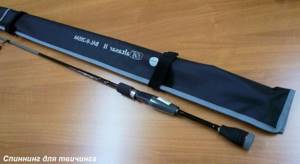
The basic rule of twitching is that all fishing methods are good, you just need to choose the right intensity. For spinning fishing with heavy and sinking wobblers, you should use a softer game - the fish you will catch are large and inactive. If you use light baits and a hard jerking method, then you can catch muscular and fast fish.

